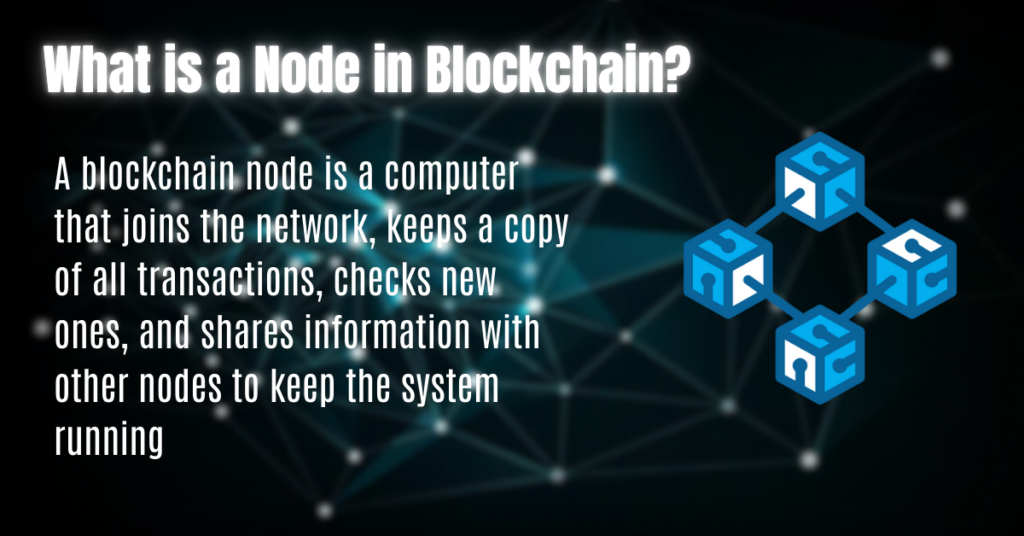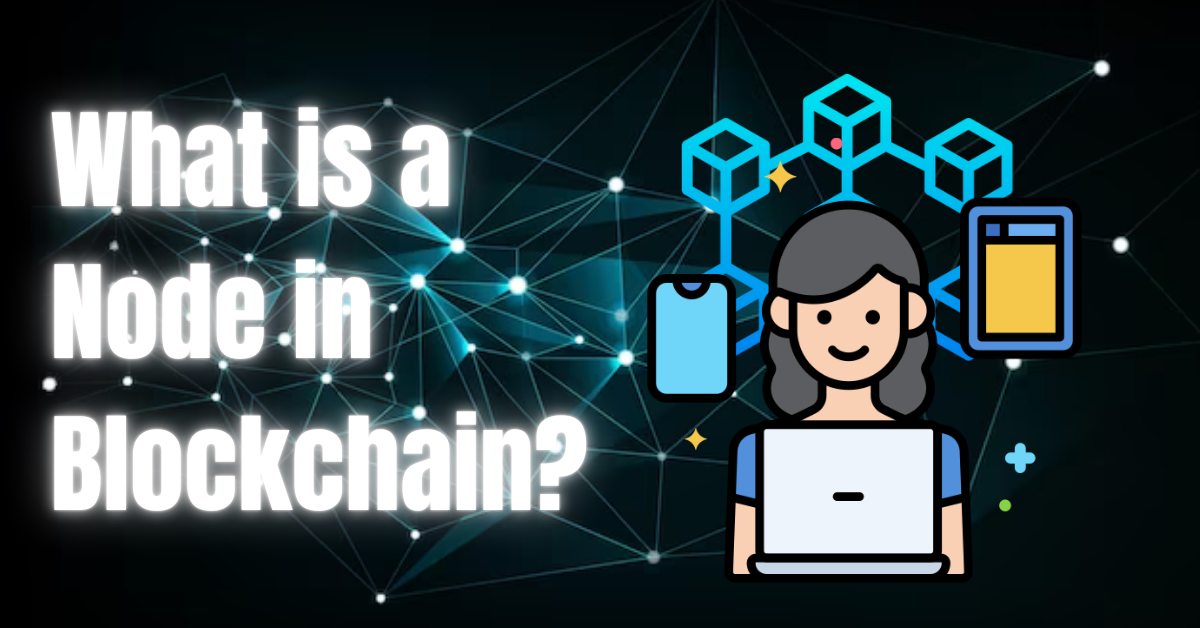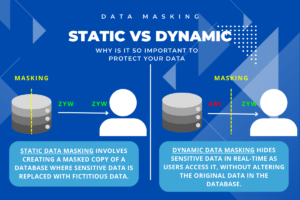Introduction
What is a Node in Blockchain?
When you hear the word “blockchain,” Bitcoin, Ethereum, or NFTs might pop into your mind. But what really keeps these systems running is a network of devices—known as blockchain nodes.
Don’t worry about the jargon; simply put, a node in blockchain is a device, often a computer, that’s key to keeping the blockchain secure and accurate. Think of it as a bookkeeper who records transactions, checks for accuracy, and keeps them stored safely.
Check more relevant info in this post about What Are Decentralized Storage Networks?
In this post, we’ll explore what is a node in blockchain, why it matters, and how it functions.
Let’s get started on what is a node in blockchain!
Table of Contents
Key Takeaways
- What is a Node in Blockchain? A node is any device connected to a blockchain network, responsible for validating and relaying transactions, and ensuring the blockchain’s accuracy and data security.
- Nodes are crucial devices in blockchain networks that validate and relay transactions, ensuring security and transparency.
- Learn about the different types of nodes, including full nodes, light nodes, mining nodes, and masternodes, and their specific roles.
- Nodes play a critical role in maintaining the integrity and security of blockchain networks by storing copies of the blockchain and validating transactions.
- Setting up and running your own node can contribute to the network’s security and confidence, offering a rewarding experience.
What is a Blockchain Node?
At its simplest, a blockchain node is a communication point within a network. More technically, it’s any device linked to a blockchain network with the task of validating and relaying transactions. Picture a blockchain as a decentralized ledger that holds information—each node keeps a copy of this ledger. This setup boosts transparency and security. Even if one node fails or gets hacked, the other nodes keep the blockchain’s integrity intact.
Nodes come in different types with various roles. Some are basic, only storing a copy of the blockchain, while others take on more complicated tasks, like verifying transactions and creating new blocks. Each node in the network connects to the others, ensuring all copies of the blockchain stay in sync.
Types of Blockchain Nodes
There are several kinds of nodes within a blockchain network, each with a unique role. Here’s a breakdown of the most common types:
Full Nodes
A full node holds a complete copy of the blockchain’s history. It records every transaction ever made. Full nodes are crucial to the blockchain, as they validate transactions and blocks, making sure the blockchain’s rules, known as consensus rules, are followed. These nodes download every block and transaction, checking them against the rules. If something doesn’t match up, the full node rejects it.
In the Bitcoin network, a full node downloads and stores the entire Bitcoin blockchain, which is over 400 GB in data size. It checks every transaction and block to prevent anyone from spending the same Bitcoin twice (a problem known as double-spending).

Light Nodes
Light nodes, also called lightweight nodes, don’t store a full copy of the blockchain. Instead, they download a small portion, particularly the block headers, which summarize the blocks. Light nodes rely on full nodes for the data they need to validate transactions. They’re faster and use less storage, making them great for devices with limited resources like smartphones.
If you have a cryptocurrency wallet app on your phone, it likely operates as a light node. It checks with a full node to verify transactions without storing the entire blockchain.
Mining Nodes
Mining nodes are special full nodes that create new blocks in the blockchain. These nodes compete to solve tough mathematical problems—a process known as mining. The first mining node to solve the problem gets to add a new block to the blockchain and earns cryptocurrency (e.g., Bitcoin) as a reward. Mining nodes play a key role in the blockchain by securing the network and processing transactions.
In the Bitcoin network, miners use powerful computers to solve cryptographic puzzles. When they successfully mine a block, they earn Bitcoin as a reward.
Masternodes
Masternodes are more powerful than regular nodes and offer extra services to the network, such as enabling instant transactions or participating in governance decisions. Running a masternode usually requires locking up a large number of coins. In return, masternodes often receive rewards similar to mining nodes.
Dash, a popular cryptocurrency, uses masternodes to enable features like InstantSend, which allows for nearly instant transactions, and PrivateSend, which offers enhanced privacy.

How Do Blockchain Nodes Work?
Now that we’ve covered the types of nodes, let’s look at how they work together to keep the blockchain running smoothly.
Storing the Blockchain
Every node on the network keeps a copy of the blockchain. Full nodes store the entire blockchain, while light nodes only keep the parts they need. This redundancy ensures that even if some nodes go offline, the blockchain keeps working.
Validating Transactions
When a transaction is made, it’s broadcast to the network. Full nodes validate it by checking if the sender has enough funds, if the format is correct, and if the signature is valid. If everything checks out, the transaction is added to a pool of unconfirmed transactions.
Adding Blocks to the Blockchain
Mining nodes take transactions from this pool and try to add them to a new block. They do this by solving a cryptographic puzzle, which requires a lot of computational power. Once a mining node solves the puzzle, it broadcasts the new block to the network.
Consensus Mechanism
For the new block to be added, it must be accepted by most nodes in the network. This is where the consensus mechanism comes in. The most common mechanisms are Proof of Work (PoW) and Proof of Stake (PoS). In PoW, mining nodes compete to solve the puzzle, and the first to succeed adds the block. In PoS, nodes are chosen to add blocks based on the number of coins they hold and are willing to “stake” as collateral.
Propagating the Blockchain
Once a block is added, it’s shared across the network. Each node updates its copy of the blockchain to include the new block. This process continues as new transactions are made and new blocks are mined.

The Role of Nodes in Blockchain Security
One standout feature of blockchain technology is its security, and nodes play a big part in this. Since each node has a copy of the blockchain, tampering with data on one node won’t affect the others. For an attack to succeed, a malicious actor would need to control more than half of the network’s nodes—a nearly impossible feat in large, well-established networks like Bitcoin or Ethereum.
This decentralized setup makes blockchain resistant to censorship and fraud. Even if a government or corporation wanted to shut down a blockchain, they would need to locate and disable every single node, which is incredibly tough to do.
Why Are Nodes Important?
Without nodes, a blockchain wouldn’t exist. They’re the backbone of the network, making sure transactions are verified and blocks are added securely. Nodes also keep the network decentralized, which prevents any single entity from taking control, making the network more secure.
Nodes also matter for:
- Transparency: Since each node has a copy of the blockchain, anyone can audit the network at any time.
- Security: Nodes work together to verify transactions, making it nearly impossible for fraudulent transactions to go through.
- Resilience: The network keeps running even if some nodes go offline, as the blockchain is stored across many devices.

How to Run Your Own Node
Running your own blockchain node can be rewarding, especially if you’re keen on contributing to the network and helping to keep it secure. Here’s a basic guide on how to set up your own node:
- Choose the Blockchain: Decide which blockchain you want to support. Bitcoin and Ethereum are popular choices, but many others exist.
- Prepare Your Hardware: Running a full node requires a decent amount of storage, processing power, and bandwidth. Make sure your computer meets the minimum requirements.
- Download the Software: Most blockchains offer node software you can download and install on your computer. For Bitcoin, you would use Bitcoin Core; for Ethereum, you might use Geth or Parity.
- Sync with the Network: After installing the software, your node will need to download and sync with the blockchain. This process can take some time, especially for large blockchains like Bitcoin.
- Stay Connected: Once your node is up and running, keep it online as much as possible. The more nodes that are online, the stronger and more secure the network becomes.
- Join the Community: Many blockchain projects have active communities of node operators. Joining these communities can help you troubleshoot issues, stay updated on the latest developments, and connect with others who share your interests.
The Future of Blockchain Nodes
As blockchain technology grows, the role of nodes will change too. One trend is the development of more efficient consensus mechanisms that lower the energy use tied to mining nodes. For instance, Ethereum is shifting from Proof of Work to Proof of Stake with its Ethereum 2.0 upgrade, aiming to make the network more scalable and eco-friendly.
Another growth area is decentralized applications (dApps). As more dApps are built on blockchains, the need for nodes to support these applications will rise. This could lead to specialized nodes optimized for running specific dApps.
Lastly, as blockchain becomes more widespread, more ordinary people may start running nodes on their personal devices, contributing to a truly decentralized internet.

Conclusion
Grasping what is a node in blockchain helps you better understand how this groundbreaking technology functions.
Nodes are the backbone of a blockchain, keeping the network secure, decentralized, and operational. Whether you’re just curious or thinking about running your own node, understanding their role will give you a deeper appreciation for blockchain technology’s complexity and potential.
In the world of blockchain, nodes will continue to be a critical piece, pushing innovation forward and ensuring that the decentralized future we imagine stays within reach. So, the next time you hear about blockchain, remember the nodes working behind the scenes to make it all possible.
FAQ – What is a Node in Blockchain?
What is a node in blockchain?
A node in blockchain is a device that participates in the network by validating and relaying transactions and maintaining a copy of the blockchain.
What are the different types of blockchain nodes?
The main types of blockchain nodes include full nodes, light nodes, mining nodes, and masternodes, each serving a unique role in the network.
Why are nodes important in blockchain technology?
Nodes are vital for ensuring the security, transparency, and decentralization of the blockchain, preventing fraud and maintaining the network’s integrity.
How does a mining node differ from a full node?
While both are full nodes, a mining node actively participates in creating new blocks by solving cryptographic puzzles, whereas a full node focuses on validating transactions and storing the entire blockchain.
Can I run my own blockchain node, and how?
Yes, you can run your own blockchain node by choosing a blockchain, setting up the required hardware and software, and staying connected to the network to help secure and maintain the blockchain.





